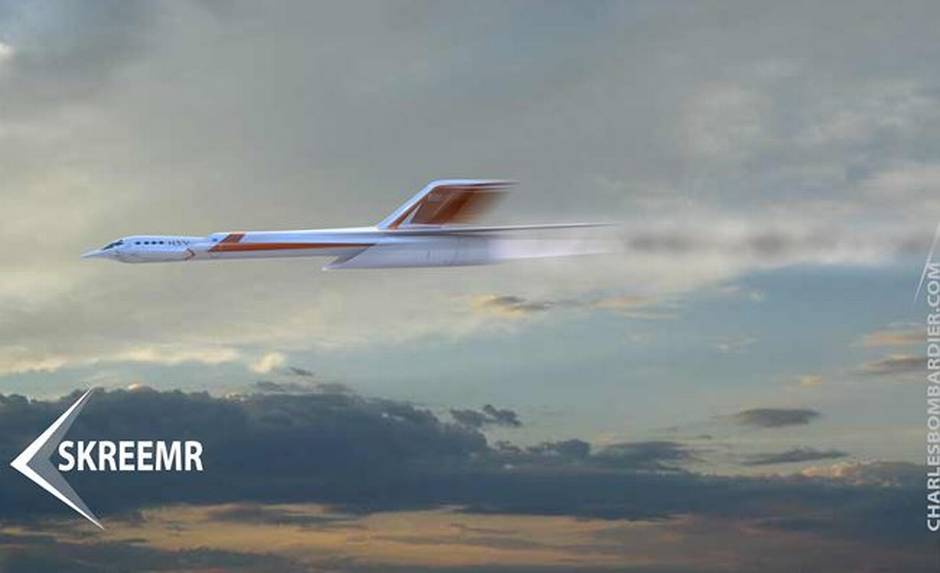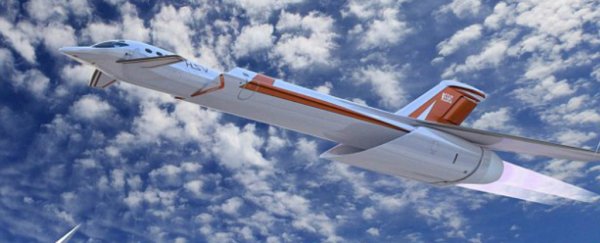A Canadian engineer has come up with a new concept for a four-winged scramjet that could carry 75 passengers at speeds of up to Mach 10 - which is 10 times the speed of sound and five times faster than Concorde. That means the proposed Skreemr jet could cross the Atlantic in just half an hour.
Unfortunately, the design is purely conceptual and the designers admit that it's unlikely to ever be realised, due to the current limitations of scramjet technology. But it's still a pretty cool glimpse into what we could one day achieve with air travel.
As most science lovers will know, scramjet systems work by combusting liquid using oxygen taken from the atmosphere passing through the aircraft. This means that, unlike traditional propulsion systems, the craft doesn't need to carry any liquid oxygen, so the whole thing becomes a lot lighter, and therefore faster.
But in order to work properly and compress the incoming oxygen without the need for moving parts, scramjets need to be travelling faster than the speed of sound, at around Mach 4, which is something that no passenger plane has ever achieved - Concorde maxed out at Mach 2.04.
So while scramjet systems are already being developed and trialled in drone technology, mainly for military purposes, the technology is not being considered for passenger transport.
But this concept, created by Canadian inventor and engineer Charles Bombardier, shows how you could merge the two - although it's not clear how commercially viable or successful it would be in practice.
Still, the idea is pretty cool. First off, to get the Skreemr jet to Mach 4, the aircraft is launched from a magnetic railgun launching system. This is a similar system to one that NASA is considering to help launch spacecraft, and involves a magnetic field accelerating the jet along a set of rails at incredible speed. It pretty much works in the same way as the maglev trains in Japan, which levitate the train carriage to avoid friction.
 Charles Bombardier
Charles Bombardier
"This system would need to be long enough to achieve supersonic speed without taxing the passengers with too much g-force," writes Bombardier in The Globe and Mail.
Once propelled forward by the launch system, two rockets would kick in, burning liquid-oxygen and kerosene to boost or maintain the scramjet at Mach 4, depending on how effective the launch is. This requires a little bit of liquid oxygen to be stored on board, but at Mach 4 the scramjet engine would fire up, and the jet would then be able to run using just the oxygen outside the planet to combust hydrogen fuel.
 Charles Bombardier
Charles Bombardier
"It might be possible to skip the rocket part which would be in use from maglev launch to the scramjet ignition," writes Bombardier, "but this would depend on two things: the materials used to withstand the heat and pressure on the aircraft, and the acceleration that could be sustained by the occupants of the aircraft."
His vision for the passenger plane was brought to life by designer Ray Mattison, and the plans show the futuristic-looking design travelling along the maglev track before shooting into the air.
 Charles Bombardier
Charles Bombardier
In theory, the jet could travel at speeds of up to 12,250 km/h, and although it's unlikely to ever be built, Bombardier has also thought about the green credentials of the project: "The magnetic railgun could use clean electricity to launch the aircraft, and the rockets and scramjets could burn hydrogen manufactured with hydro-electricity."
But don't be too disappointed that this design isn't going to become reality anytime soon, because just a few months ago, Airbus patented a jet that could take you to from London to New York in an hour, and it's being developed as you read this. The future of travel is looking fast.
